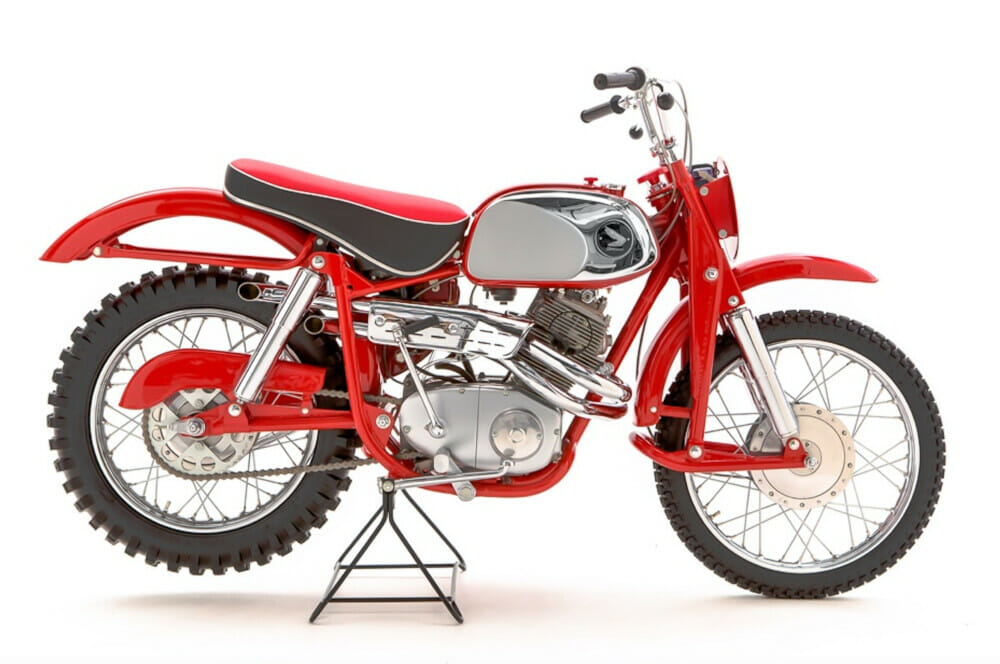| November 6, 2022
Cycle News Archives
COLUMN
A Rare Racer
By Jim Scaysbrook
Given that Honda and Yamaha’s earliest attempts at racing machinery were designed to be used on the rugged dirt-surfaced courses in Japan like Asama Mountain, they were off-roaders as much as road racers—street scramblers if you like, and often shod with knobby tires.
It was not until the early ’60s that the designs became slightly more refined (coincidentally with the increased popularity of motocross in Japan as a result of Australian Tim Gibbes’ Racing Schools conducted there from 1963). But back in 1957, what Honda offered the budding racer was what the factory termed the RC70F, a 250cc twin using the C70 (and later C71) engine, which had the “rotary” gearbox favored by several of the Japanese manufacturers. This had first gear at the bottom of the shift pattern, followed by neutral, followed (if the rider kept pressing downwards) by top gear and so on.
The RC70 was offered for sale in Japan as early as 1958, and one school of thought is that the overall look was influenced by the German Adler Cross Scrambler. The two certainly shared many similarities, notably the long-travel-leading-link front suspension and the wide cradle tubular steel frame. The frame itself is remarkably similar to the Adler. The RC70 was available with or without lighting.
The German Adler Cross scrambler may or may not have provided the inspiration for the Honda RC70—it depends who you ask. This particular restoration belongs to Dutch spare parts company, CMS. Photo Courtesy of CMS
Of course, the late ’50s was also the period when Honda was keenly eyeing the U.S. market, taking the significant step of setting up their own distribution center in California—American Honda—in early 1960.
However, prior to that, at least four examples of the production RC70 found their way to USA. Two went to Herb Uhl, who had a motorcycle dealership in Boise, Idaho, and who had competed in the International Six Days Trial in Europe on two occasions, riding with his brother Bill who was an Expert-class flat track rider. Herb noted later, “I imported a couple of RC70 off-road bikes from Honda Japan in early 1959 and they had excellent leading-arm forks.”
About the same time, another pair of RC70s was sent to Allan D’Alo in California. D’Alo was an amateur racer from Norwalk, California, who annually competed in the Catalina Island Grand Prix on an MV Agusta. The Hondas were imported ostensibly to test the market, and came with basic C70 250cc Dream engines, complete with rotary gearboxes.
Local racers were still wrestling with the left-side-shift gear levers on these early Hondas, because many of the European racing bikes came with right-side-shift transmission selectors. Having to remember which side of the engine to change gears with, as well as coping with the “rotary” gearbox function, was more than most riders wanted to deal with back then.
The “fix” for the RC70 riders was to commandeer engine assemblies from the 1959 CE71s, once they were released for sale through the fledgling AHMC distributorship. The electric-start CE71 was Honda’s U.S.-spec “Dream Super Sport” model, which featured a conventional return-shift transmission, a larger 24mm carburetor (vs. 22mm carburetors that were stock on Dream engines) and a horsepower upgrade due to higher compression pistons and more aggressive camshaft timing.
One of the RC70s was assigned to budding motocross rider Preston Petty, who later founded the plastic mudguard revolution that found a ready market in the booming off-road scene. Petty won several local Southern California races on the RC70F, which later had a CE71 engine fitted. As the Honda was developed, some reports say Petty trimmed off the factory-installed leading-link suspension front end and machined up a new steering head which could hold British AJS telescopic front forks and a wider, smaller 18-inch front wheel in place of the standard 2.75 x 19-inch front tire.
The RC70F varied slightly in specification during the period of its cataloged existence, some being fitted with a high-level exhaust pipe with a substantial muffler on the right-hand side, others with straight-through pipes exiting in front of the right-hand rear shock absorber, and others with low road-style pipes and muffler. There were also dry-sump versions available.
The 1960-61 pre-production Honda 250 Scrambler prototypes also came with single-carb Dream engines, but with return shift transmissions. When the 1961 CB72 Hawk sportbikes were released, the first thing that happened to the “next generation” 250 Scrambler was again a motor transplant, but this time from a CB72, which had dual carbs, even higher-compression pistons and a 10,000 rpm redline.
In fairness to Honda, they were not the only ones who offered “rotary gearboxes” to the public. Early Yamahas, the Bridgestone 175s and Lilac motorcycles also had this feature for a few years, among other now-extinct manufactured models. Honda continued to offer the rotary-gearbox option on domestic 250-305cc Dreams and CYP77 Police bikes into the mid-1960s, but no other “large” models were so equipped after that. CN